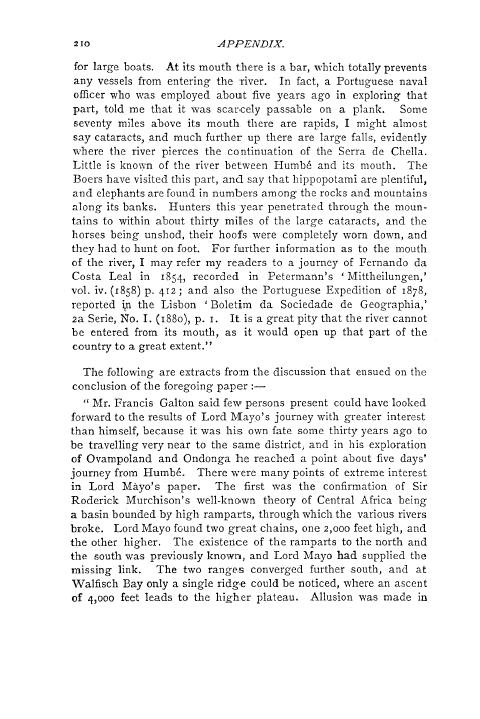210 APPENDIX.
for large boats. At its mouth there is a bar, which totally prevents any vessels from entering the river. In fact, a Portuguese naval officer who was employed about five years ago in exploring that part, told me that it was scarcely passable on a plank. Some seventy miles above its mouth there are rapids, I might almost say cataracts, and much further up there are large falls, evidently where the river pierces the continuation of the Serra do Chella. Little is known of the river between Humbe and its mouth. The Boers have visited this part, and say that hippopotami are plentiful, and elephants are found in numbers among the rocks and mountains along its banks. Hunters this year penetrated through the mountains to within about thirty miles of the large cataracts, and the horses being unshod, their hoofs were completely worn down, and they had to hunt on foot. For further information as to the mouth of the river, I may refer my readers to a journey of Fernando da Costa Leal in 1854, recorded in Petermann's ' Mittheilungen,' vol. iv. (1858) p. 412 ; and also the Portuguese Expedition of 1878, reported in, the Lisbon ` Boletim da Sociedade de Geographia,' 2a Serie, No. I. (188o), p. i. It is a great pity that the river cannot be entered from its mouth, as it would open up that part of the country to a great extent."
The following are extracts from the discussion that ensued on the conclusion of the foregoing paper :
" Mr. Francis Galton said few persons present could have looked forward to the results of Lord Mayo's journey with greater interest than himself, because it was his own fate some thirty years ago to be travelling very near to the same district, and in his exploration of Ovampoland and Ondonga he reached a point about five days' journey from Humbe. There were many points of extreme interest in Lord Mayo's paper. The first was the confirmation of Sir Roderick Murchison's well-known theory of Central Africa being a basin bounded by high ramparts, through which the various rivers broke. Lord Mayo found two great chains, one 2,000 feet high, and the other higher. The existence of the ramparts to the north and the south was previously known, and Lord Mayo had supplied the missing link. The two ranges converged further south, and at Walfisch Bay only a single ridge could be noticed, where an ascent of 4,000 feet leads to the higher plateau. Allusion was made in

